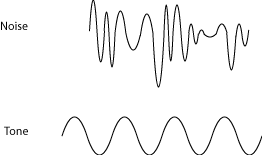| << Chapter < Page | Chapter >> Page > |
Music is sound that's organized by people on purpose, to dance to, to tell a story, to make other people feel a certain way, or just to sound pretty or be entertaining. Music is organized on many different levels. Sounds can be arranged into melodies , harmonies , rhythms , textures and phrases . Beats , measures , cadences , and form all help to keep the music organized and understandable. But the most basic way that music is organized is by arranging the actual sound waves themselves so that the sounds are interesting and pleasant and go well together.
A rhythmic, organized set of thuds and crashes is perfectly good music - think of your favorite drum solo - but many musical instruments are designed specifically to produce the regular, evenly spaced sound waves that we hear as particular pitches . Crashes, thuds, and bangs are loud, short jumbles of lots of different wavelengths. These are the kinds of sound we often call "noise", when they're random and disorganized, but as soon as they are organized in time ( rhythm ), they begin to sound like music. (When used as a scientific term, noise refers to continuous sounds that are random mixtures of different wavelengths, not shorter crashes and thuds.)
However, to get the melodic kind of sounds more often associated with music, the sound waves must themselves be organized and regular, not random mixtures. Most of the sounds we hear are brought to our ears through the air. A movement of an object causes a disturbance of the normal motion of the air molecules near the object. Those molecules in turn disturb other nearby molecules out of their normal patterns of random motion, so that the disturbance itself becomes a thing that moves through the air - a sound wave. If the movement of the object is a fast, regular vibration, then the sound waves are also very regular. We hear such regular sound waves as tones , sounds with a particular pitch . It is this kind of sound that we most often associate with music, and that many musical instruments are designed to make.

Musicians have terms that they use to describe tones. (Musicians also have other meanings for the word "tone", but this course will stick to the "a sound with pitch" meaning.) This kind of (regular, evenly spaced) wave is useful for things other than music, however, so scientists and engineers also have terms that describe pitched sound waves. As we talk about where music theory comes from, it will be very useful to know both the scientific and the musical terms and how they are related to each other.
For example, the closer together those evenly-spaced waves are, the higher the note sounds. Musicians talk about the pitch of the sound, or name specific notes , or talk about tuning . Scientists and engineers, on the other hand, talk about the frequency and the wavelength of the sound. They are all essentially talking about the same things, but talking about them in slightly different ways, and using the scientific ideas of wavelength and frequency can help clarify some of the main ideas underlying music theory.

Notification Switch
Would you like to follow the 'Understanding your french horn' conversation and receive update notifications?